
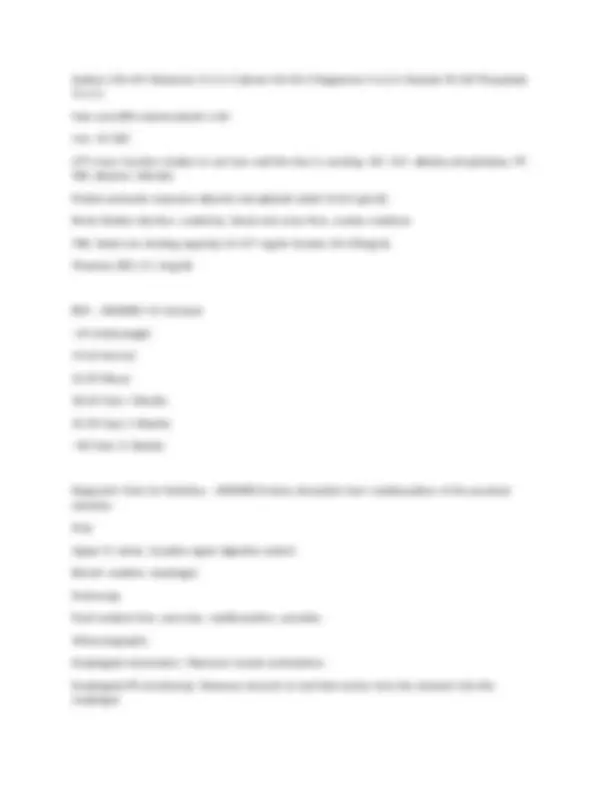
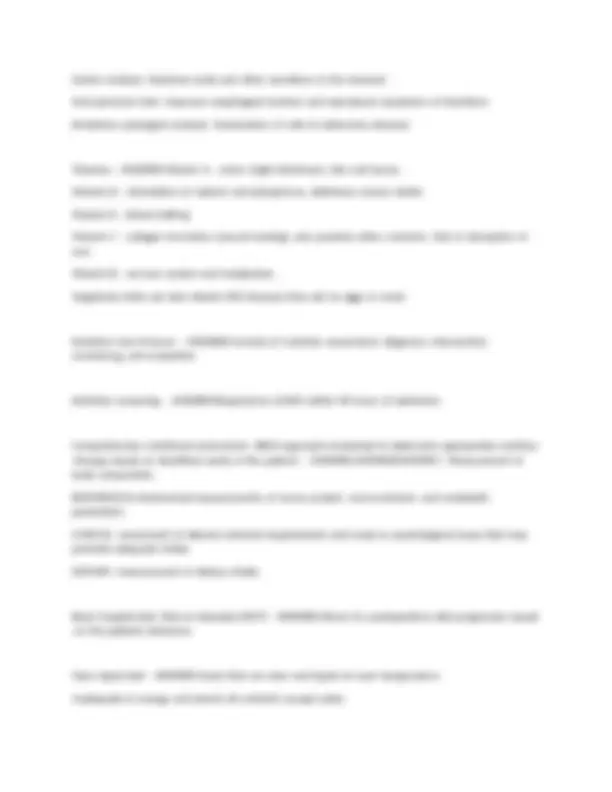

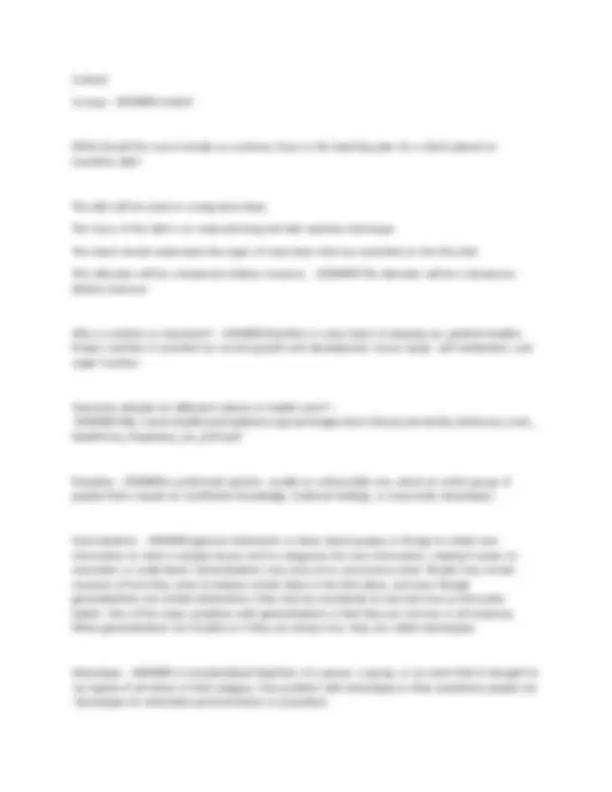
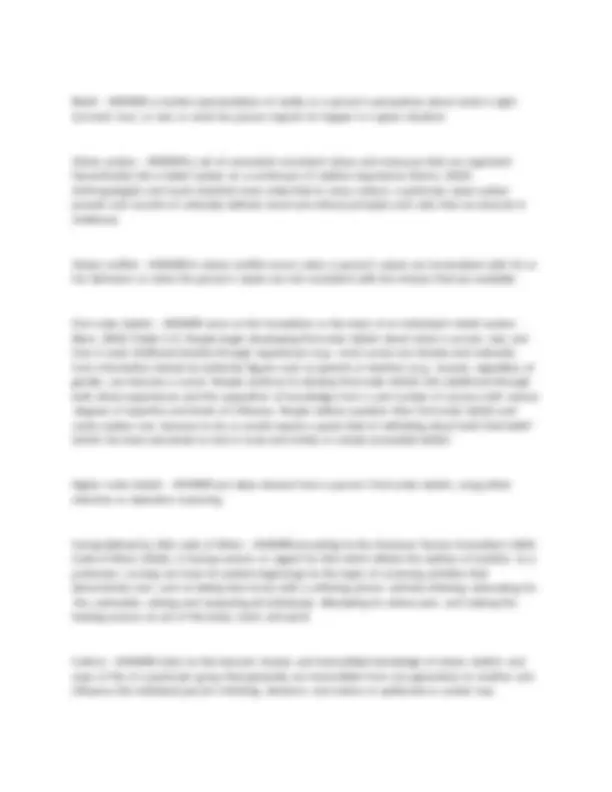
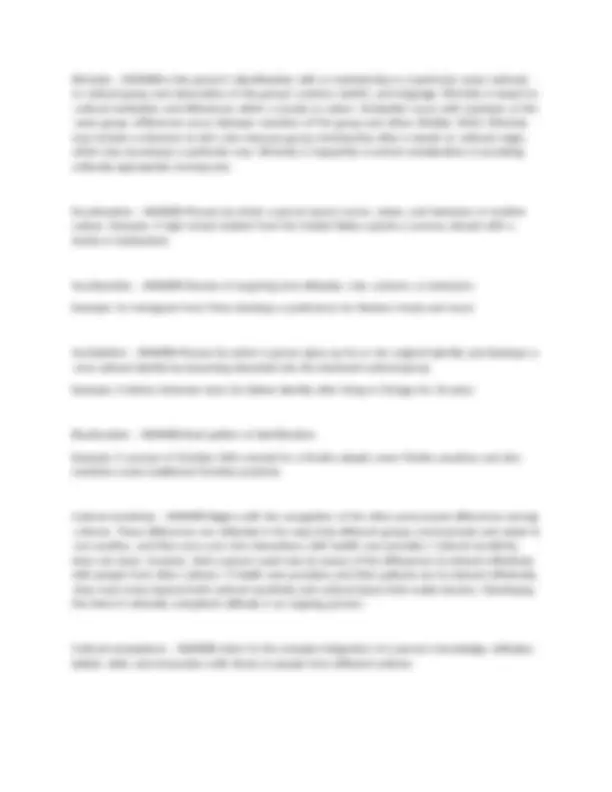
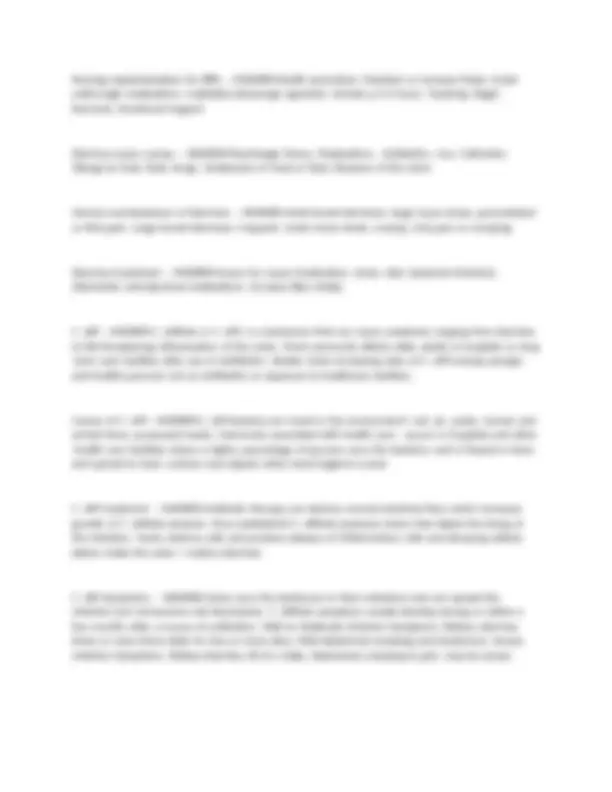
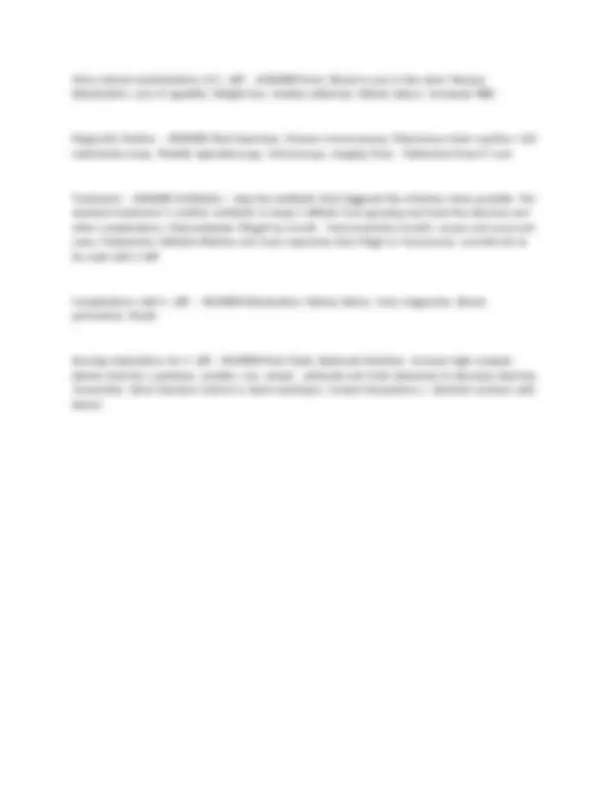


Study with the several resources on Docsity

Earn points by helping other students or get them with a premium plan


Prepare for your exams
Study with the several resources on Docsity

Earn points to download
Earn points by helping other students or get them with a premium plan
Community
Ask the community for help and clear up your study doubts
Discover the best universities in your country according to Docsity users
Free resources
Download our free guides on studying techniques, anxiety management strategies, and thesis advice from Docsity tutors
RNSG 1430 EXAM 2 with precise detailed answers
Typology: Exams
1 / 14

This page cannot be seen from the preview
Don't miss anything!









Knock |knock, |who's |there?! |HIPPA! |HIPPA |WHO?! |- |ANSWER-Sorry |I |can't |disclose |that |information. Define |the |concept |of |Nutrition |(including |definition, |antecedents, |and |attributes) |- |ANSWER-Nutrition |is |the |process |by |which |the |body |absorbs, |transports, |and |eliminate |nutrients |in |food. | Antecedents |are |normal |alimentary |track, |ability |to |afford |food, |ability |to |swallow |and |chew, |and | ability |to |eliminate |waste. | Attributes |are |adequate |intake |for: |energy, |growth, |development, |and |tissue |repair! Review |physical |assessment |and |nursing |interview/history |of |patients |experiencing |adequate | nutritional |findings |- |ANSWER-Adequate |nutritional |findings |are: |Sufficient |amount |of |macronutrients, | minerals, |water, |and |vitamins. |Patient |will |have |a |BMI |of |19-24. | Normal |development |and |no |underlying |diseases. |Specifically |no |GI/GU |abnormalities. What |is |imbalanced |nutrition: |less |than |body |requirements? |- |ANSWER-The |state |in |which |an | individual |experiences |an |intake |of |nutrients |insufficent |to |meet |metabolic |needs -less |than |body |requires |for |metabolic |needs -less |than |body |requirements: |less |than |20% |of |their |body |weight, |inadequate |intake -ideal |weight |based |on |height |weight, |etc What |is |imbalanced |nutrition: |more |than |body |requirements? |- |ANSWER-The |state |in |which |an | individual |experiences |an |intake |of |nutrients |that |exceed |metabolic |needs -exceeds |metabolic |needs -more |than |20% |above |body |weight |analysis -related |to |inadequate |physical |activity
Gastric |analysis- |Examines |acids |and |other |secretions |in |the |stomach Acid |perfusion |test- |measures |esophageal |function |and |reproduces |symptoms |of |heartburn Exfoliative |cytological |analysis- |Examination |of |cells |to |determine |diseases Vitamins |- |ANSWER-Vitamin |A |- |vision |(night |blindness), |skin |and |bones. Vitamin |D |- |stimulation |of |calcium |and |phosphorus, |deficiency |causes |rickets. Vitamin |K |- |blood |clotting Vitamin |C |- |collagen |formation |(wound |healing), |also |protects |other |nutrients. |Aids |in |absorption |of | iron. Vitamin |B |- |nervous |system |and |metabolism. | Vegetarian |diets |can |lack |vitamin |B12 |because |they |eat |no |eggs |or |meat. Nutrition |Care |Process: |- |ANSWER-Consists |of |nutrition |assessment, |diagnosis, |intervention, | monitoring, |and |evaluation. Nutrition |screening. |- |ANSWER-Required |by |JCAHO |within | 48 |hours |of |admission. Comprehensive |nutritional |assessment, |ABCD |approach-conducted |to |determine |appropriate |nutrition |therapy |based |on |identified |needs |of |the |patient. |- |ANSWER-ANTHROPOMETRIC- |Measurement |of | body |composition. BIOCHEMICAL-biochemical-measurements |of |serum |protein, |micronutrients, |and |metabollic | parameters. CLINICAL- |assessment |of |altered |nutrional |requirements |and |scoial |or |psychological |issues |that |may | preclude |adequate |intake. | DIETARY- |measurement |of |dietary |intake. Basic |hospital |diet: |Diet |as |tolerated |(DAT) |- |ANSWER-Allows |for |postoperative |diet |progression |based |on |the |patients |tolerance. Clear |liquid |diet |- |ANSWER-Foods |that |are |clear |and |liquid |at |room |temperature. Inadequate |in |energy |and |almost |all |nutrients |except |water.
Should |not |be |used |for |more |than | 24 |hours. Relationship |to |hospital |malnutrition. | Made |up |of |foods |that |are |clear |liquids |or |become |clear |liquids |at |room |temperature. Only |foods |you |can |see |through |are |allowed. Food |types |allowed |on |Clear |liquid |diet |- |ANSWER-Black |coffee-no |milk |or |creamer Tea-no |sugar |or |lemon Clear |fat |free |broth Bouillon Carbonated |clear |drinks Clear |fruit |juices Gelatin Fruit |ices-no |pulp Popsicles Full |liquid |diets |- |ANSWER-Foods |that |are |liquid |at |room |temperature. Often |used |if |a |pt |has |difficulty |chewing |or |swallowing. Can |supply |adequate |energy |and |nutrition. Potential |problem |with |lactose |intolerance. | Concern |with |high |saturated |fat |and |cholesterol. Foods |allowed |on |Full |liquid |diet |- |ANSWER-Everything |on |a |clear |liquid |diet |and |extra. Water Fruit |juices, |including |nectars |and |juices |WITH |pulp. Butter, |margarine, |oil, |custard, |pudding. Plain |icecream, |frozen |yogurt, |and |sherbert. Fruit |ices |and |popsicles. Sugar, |honey, |and |syrups Soup |broth-bouillon, |consomme, |and |strained |cream |soups-but |no |solids. |
Food |supplements |or |between-meals |snacks |may |be |used |if |needed |to |add |kcal Soft |diets |can |contain |"hard |to |chew" |foods |such |as |white |toast This |diet |is |not |appropriate |for |patients |requiring |mechanical |soft |diets When |caring |for |an |elderly |client |who |has |difficulty |chewing, |the |nurse |identifies |which |diet |is |most | appropriate? Low |residue |diet Full |liquid |diet High-protein |diet Mechanical |soft |diet |- |ANSWER-Mechanical |soft |diet A |postoperative |client |has |been |placed |on |a |clear |liquid |diet. |The |nurse |should |provide |the |client | with |which |items(s) |that |are |allowed |to |be |consumed |on |this |diet? |Select |all |that |applies. Broth Coffee |black Gelatin Pudding Vegetable |juice |with |pulp Pureed |vegetables |- |ANSWER-broth | black |coffee gelatin A |client |who |is |recovering |from |surgery |has |been |advanced |to |a |full |liquid |diet. |The |client |is |looking | forward |to |the |diet |change |because |he |has |been |"bored" |with |the |clear |liquid |diet. |The |nurse |should | offer |which |full |liquid |item |to |the |client? Tea Gelatin
Custard Ice |pop |- |ANSWER-custard What |should |the |nurse |include |as |a |primary |focus |in |the |teaching |plan |for |a |client |placed |on | transition |diet? The |diet |will |be |used |on |a |long |term |basis. The |focus |of |the |diet |is |on |meal |planning |and |diet |selection |technique. The |client |should |understand |the |types |of |food |items |that |are |restricted |on |the |this |diet. This |diet |plan |will |be |a |temporary |dietary |measure. |- |ANSWER-This |diet |plan |will |be |a |temporary | dietary |measure. Why |is |nutrition |so |important? |- |ANSWER-Nutrition |is |a |key |factor |in |keeping |our |patients |healthy. | Proper |nutrition |is |essential |for |normal |growth |and |development, |tissue |repair, |cell |metabolism, |and | organ |function. Awesome |website |for |different |cultures |in |health |care!!! |- |ANSWER-http://www.healthcarechaplaincy.org/userimages/doc/Cultural_Sensitivity_Dictionary_from_ HealthCare_Chaplaincy_Jan_2013.pdf Prejudice |- |ANSWER-a |preformed |opinion, |usually |an |unfavorable |one, |about |an |entire |group |of | people |that |is |based |on |insufficient |knowledge, |irrational |feelings, |or |inaccurate |stereotypes Generalization |- |ANSWER-(general |statements |or |ideas |about |people |or |things) |to |relate |new | information |to |what |is |already |known |and |to |categorize |the |new |information, |making |it |easier |to | remember |or |understand. |Generalizations |may |arise |at |an |unconscious |level. |People |may |remain | unaware |of |how |they |came |to |believe |certain |ideas |in |the |first |place, |and |even |though | generalizations |are |mental |abstractions, |they |may |be |considered |as |real |and |true |as |first-order | beliefs. |One |of |the |major |problems |with |generalizations |is |that |they |are |not |true |in |all |instances. | When |generalizations |are |treated |as |if |they |are |always |true, |they |are |called |stereotypes. Stereotype |- |ANSWER-A |conceptualized |depiction |of |a |person, |a |group, |or |an |event |that |is |thought |to |be |typical |of |all |others |in |that |category. |One |problem |with |stereotypes |is |that |sometimes |people |use |stereotypes |to |rationalize |personal |biases |or |prejudices.
Ethnicity |- |ANSWER-is |the |person's |identification |with |or |membership |in |a |particular |racial, |national, | or |cultural |group |and |observation |of |the |group's |customs, |beliefs, |and |language. |Ethnicity |is |based |on |cultural |similarities |and |differences |within |a |society |or |nation. |Similarities |occur |with |members |of |the |same |group; |differences |occur |between |members |of |the |group |and |others |(Kottak, |2012). |Ethnicity | may |include |a |reference |to |skin |color |because |group |membership |often |is |based |on |national |origin, | which |may |encompass |a |particular |race. |Ethnicity |is |frequently |a |central |consideration |in |providing | culturally |appropriate |nursing |care. Enculturation |- |ANSWER-Process |by |which |a |person |learns |norms, |values, |and |behaviors |of |another | culture. |Example: |A |high |school |student |from |the |United |States |spends |a |summer |abroad |with |a | family |in |Switzerland. Acculturation |- |ANSWER-Process |of |acquiring |new |attitudes, |role, |customs, |or |behaviors Example: |An |immigrant |from |China |develops |a |preference |for |Western |foods |and |music Assimilation |- |ANSWER-Process |by |which |a |person |gives |up |his |or |her |original |identity |and |develops |a |new |cultural |identity |by |becoming |absorbed |into |the |dominant |cultural |group Example: |A |Native |American |loses |his |Native |identity |after |living |in |Chicago |for | 10 |years Biculturalism |- |ANSWER-Duel |pattern |of |identification Example: |A |woman |of |Christian |faith |married |to |a |Muslim |adopts |some |Muslim |practices |and |also | maintains |some |traditional |Christian |practices Cultural |sensitivity |- |ANSWER-Begins |with |the |recognition |of |the |often |pronounced |differences |among |cultures. |These |differences |are |reflected |in |the |ways |that |different |groups |communicate |and |relate |to |one |another, |and |they |carry |over |into |interactions |with |health |care |providers. |Cultural |sensitivity | does |not |mean, |however, |that |a |person |need |only |be |aware |of |the |differences |to |interact |effectively | with |people |from |other |cultures. |If |health |care |providers |and |their |patients |are |to |interact |effectively, |they |must |move |beyond |both |cultural |sensitivity |and |cultural |biases |that |create |barriers. |Developing | this |kind |of |culturally |competent |attitude |is |an |ongoing |process. Cultural |competence |- |ANSWER-refers |to |the |complex |integration |of |a |person's |knowledge, |attitudes, | beliefs, |skills, |and |encounters |with |those |of |people |from |different |cultures
Diversity |- |ANSWER-The |unique |variations |among |and |between |individuals, |variations |that |are | informed |by |genetics |and |cultural |background, |but |that |are |refined |by |experience |and |personal | choice. Identify |when |cultural |incompetence |(negative |Consequences) |is |developing |or |has |developed. |- | ANSWER-Culture |specific |illness, |Stress-no |hope, |Breakdown |of |communication, |non |compliance, | fearful |patient Positive |outcomes |of |diversity |- |ANSWER-Culturally |congruent |care, |appropriate |child |rearing | practices, |cultural |identity, |inner |peace, |strength, |faith, |and |hope. Attributes |of |Diversity |- |ANSWER-Enculturation, |Acculturation, |Biculturalism, |application/use |of | diversity |implications, |When |interacting, |educating, |and |providing |care. Antecedents |of |Diversity |- |ANSWER-Individual |differences |and |similarities |in: |Age, |religious, |spiritual, | ethnic, |race, |cultural, |sexual |orientation, |education, |and |life |experiences. The |difference |between |passive |and |active |listening |is |that |an |active |listener |engages |with |the | speaker |while |a |passive |listener |simply |receives |the |message |without |giving |any |external |indications. | Active |listening |has |been |shown |to |be |more |effective |for |retaining |information, |and |also |makes |a | speaker |feel |more |comfortable. |- |ANSWER-Active |listening |can |consist |of |both |verbal |and |non-verbal | cues. |Non-verbal |cues, |such |as |nodding |and |eye |contact, |show |that |you |are |interested |and |engaged | in |what |the |speaker |is |saying. |Verbal |cues |can |vary |from |repeating |or |summarizing |parts |of |what |is | being |said |to |asking |appropriate |follow-up |questions |to |engage |the |speaker. Explain |the |concept |of |Elimination |(including |definition, |antecedents, |and |attributes). |- |ANSWER- Elimination |is |a |means |by |which |the |body |maintains |homeostasis, |excreting |the |unneeded |materials | from |the |body |via |urination |and |defecation. |Definition: |Elimination |is |the |excretion |of |waste |products |from |the |kidneys |and |intestines. |Antecedents: |Continent, |Bowel |Ability |to |Expel, |Feces |- |Normal, | Bladder |- |Ability |to |Void, |Peristalsis, |Adequate |Hydration/Intake. |Attributes: |Routine |voluntary |passage |of |formed |stool |with |urge |to |defecate |at |routine |intervals, |Bladder: |voluntary |control |passage |of | urine, |Adult: |>30-50mL |per |hour, |Child: |1-2mL/kg/hour, |= |Homeostasis Analyze |conditions |which |place |a |patient |at |risk |for |disruptions |in |Elimination. |- |ANSWER-Some | exemplars |of |impaired |elimination |are |Benign |Prostate |Hypertrophy |(BPH), |Urinary |Retention, | Diarrhea, |Bowel |Incontinence, |Gerontology, |Urinary |Incontinence, |Clostridium |Difficile |(C.-diff), |
Nursing |implementation |for |BPH: |- |ANSWER-Health |promotion, |Maintain |or |increase |fluids, |Avoid | cold/cough |medications, |sudafed(a-adrenergic |agonists), |Urinate |q |3-4 |hours, |Teaching, |Kegel | Exercises, |Emotional |Support Diarrhea |major |causes: |- |ANSWER-Psychologic |Stress, |Medications |, |Antibiotics, |Iron, |Cathartics, | Allergy |to |food, |fluid, |drugs, |Intolerance |of |food |or |fluid, |Diseases |of |the |colon Clinical |manifestations |of |Diarrhea: |- |ANSWER-Small |bowel |diarrheas: |large |loose |stools, |periumbilical | or |RLQ |pain. |Large |bowel |diarrheas: |frequent, |small, |loose |stools, |crampy, |LLQ |pain |or |cramping Diarrhea |treatment: |- |ANSWER-Assess |for |cause |(medication, |stress, |diet, |bacterial |infection), | Administer |anti-diarrheal |medications, |Increase |fiber |intake C. |diff |- |ANSWER-C. |difficile |or |C. |diff, |is |a |bacterium |that |can |cause |symptoms |ranging |from |diarrhea | to |life-threatening |inflammation |of |the |colon. |Most |commonly |affects |older |adults |in |hospitals |or |long |term |care |facilities |after |use |of |antibiotics. |Studies |show |increasing |rates |of |C. |diff |among |younger | and |healthy |persons |not |on |antibiotics |or |exposure |to |healthcare |facilities. Causes |of |C. |diff |- |ANSWER-C. |diff |bacteria |are |found |in |the |environment- |soil, |air, |water, |human |and | animal |feces, |processed |meats. |Commonly |associated |with |health |care |- |occurs |in |hospitals |and |other |health |care |facilities |where |a |higher |percentage |of |persons |carry |the |bacteria, |and |is |Passed |in |feces | and |spread |to |food, |surfaces |and |objects |when |hand |hygiene |is |poor C. |diff |treatment: |- |ANSWER-Antibiotic |therapy |can |destroy |normal |intestinal |flora |which |increases | growth |of |C. |difficile |bacteria. |Once |established |C. |difficile |produces |toxins |that |attack |the |lining |of | the |intestine. |Toxins |destroy |cells |and |produce |plaques |of |inflammatory |cells |and |decaying |cellular | debris |inside |the |colon |= |watery |diarrhea C. |diff |Symptoms: |- |ANSWER-Some |carry |the |bacterium |in |their |intestines |and |can |spread |the | infection |but |not |become |sick |themselves. |C. |difficile |symptoms |usually |develop |during |or |within |a | few |months |after |a |course |of |antibiotics. |Mild |to |Moderate |Infection |Symptoms: |Watery |diarrhea | three |or |more |times |daily |for |two |or |more |days, |Mild |abdominal |cramping |and |tenderness. |Severe | Infection |Symptoms: |Watery |diarrhea |10-15 |x |daily, |Abdominal |cramping |& |pain, |may |be |severe
More |clinical |manifestations |of |C. |diff: |- |ANSWER-Fever, |Blood |or |pus |in |the |stool, |Nausea, | Dehydration, |Loss |of |appetite, |Weight |loss, |Swollen |abdomen, |Kidney |failure, |Increased |WBC Diagnostic |Studies: |- |ANSWER-Stool |Specimen, |Enzyme |Immunoassay, |Polymerase |chain |reaction, |Cell | cytotoxicity |assay, |Flexible |sigmoidoscopy, |Colonoscopy, |Imaging |Tests |- |Abdominal |Xray-CT |scan Treatment: |- |ANSWER-Antibiotics |- |stop |the |antibiotic |that |triggered |the |infection |when |possible. |The | standard |treatment |is |another |antibiotic |to |keep |C.difficile |from |growing |and |treat |the |diarrhea |and | other |complications. |Metronidazole |(Flagyl) |by |mouth |: |Vancomycin(by |mouth)- |severe |and |recurrent | cases. |Fidaxomicin |(Dificid) |effective |and |more |expensive |than |Flagyl |or |Vancomycin. |Lomotil-not |to | be |used |with |C.diff Complications |with |C. |diff: |- |ANSWER-Dehydration, |Kidney |failure, |Toxic |megacolon, |Bowel | perforation, |Death Nursing |implications |for |C. |diff |- |ANSWER-Push |fluids, |Balanced |Nutrition, |Increase |high |complex | dietary |starches |( |potatoes, |noodles, |rice, |wheat |, |oatmeal) |and |fruits |(bananas) |to |decrease |diarrhea. |Prevention: |Strict |Infection |Control |a. |Hand |washing |b. |Contact |Precautions |c. |Disinfect |surfaces |with | bleach